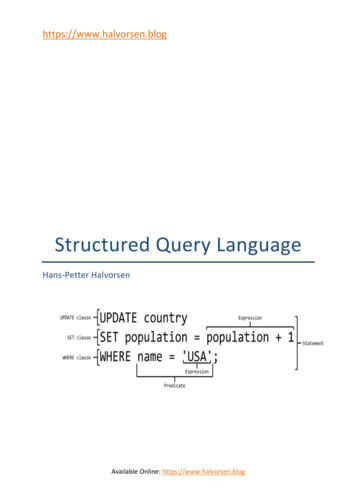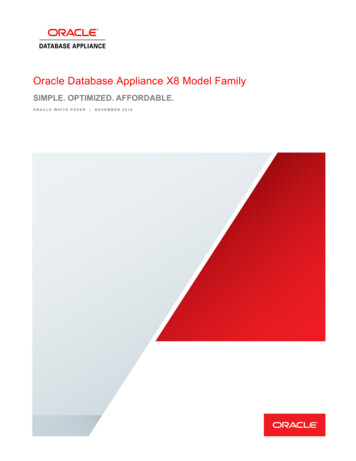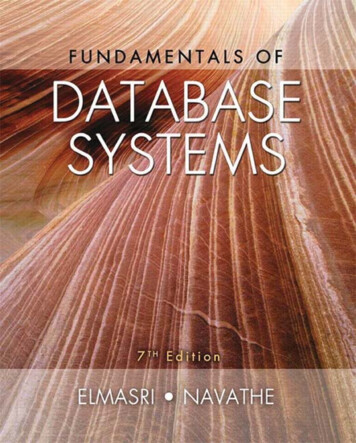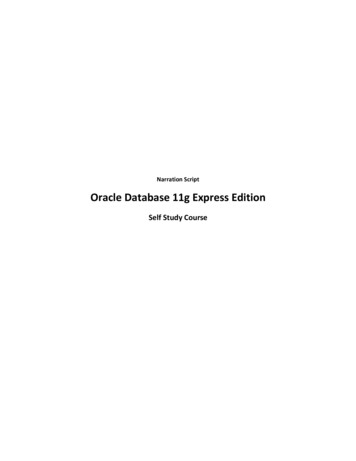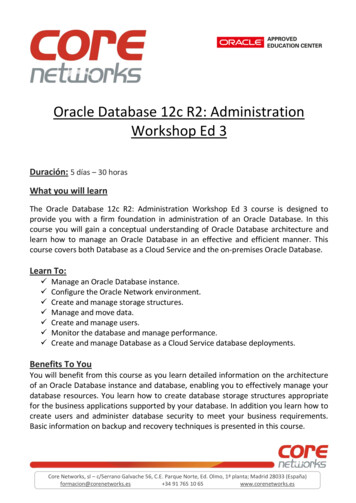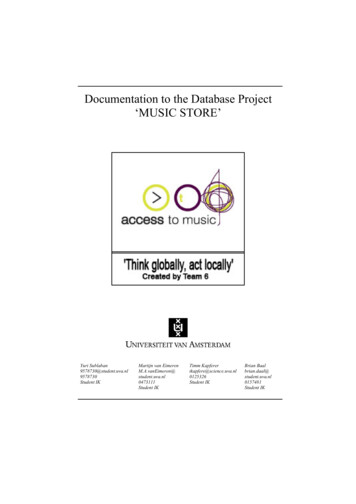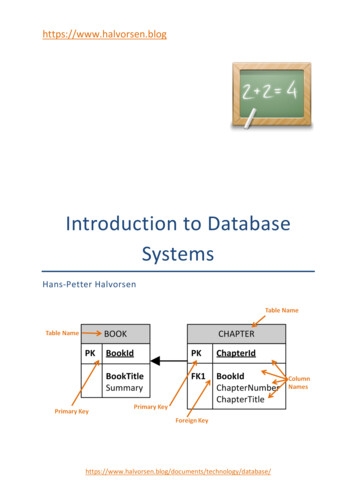
Transcription
https://www.halvorsen.blogIntroduction to DatabaseSystemsHans-Petter nology/database/
Introduction to DatabaseSystemsHans-Petter HalvorsenCopyright 2017E-Mail: hans.p.halvorsen@usn.noWeb: og
PrefaceThis document explains the basic concepts of a database system and how to communicatewith a database system.The main focus in this document is on relational databases and Microsoft SQL Server.For more information about Databases, visit my Blog:https://www.halvorsen.blogSome text in this document is based on text from www.wikipedia.org.
Table of ContentsPreface . 3Table of Contents . iv1Database Systems . 11.1 RDBMS Components . 11.2 Data warehouse . 21.3 Relational Database . 21.4 Real-time databases . 21.5 NoSQL Databases. 31.6 Database Management Systems . 31.7 MDAC. 41.7.1 ODBC . 41.7.2 OLE DB . 41.7.3 ADO (ActiveX Data Objects) . 42Relational Databases . 52.1 Tables . 52.2 Unique Keys and Primary Key . 62.3 Foreign Key . 72.4 Views . 82.5 Functions . 82.6 Stored Procedures . 92.7 Triggers . 93Structured Query Language (SQL) . 10iv
vTable of Contents3.1 Queries . 103.2 Data Manipulation . 113.3 Data Definition . 123.4 Data Types . 133.4.1 Character Strings. 133.4.2 Bit Strings . 133.4.3 Numbers . 133.4.4 Date and Time . 134Database Modelling . 144.1 ER Diagram . 144.2 Microsoft Visio. 154.3 ERwin . 175Microsoft SQL Server . 195.1 Introduction . 195.2 SQL Server Express . 195.3 SQL Server Management Studio . 205.4 Create a New Database . 205.5 Backup/Restore . 226Microsoft Office Access . 246.1 Introduction . 246.2 Example Database . 247Creating and Using Tables . 278Creating and Using Views . 309Creating and using Stored Procedures . 3110Creating and Using Triggers . 3311Creating and Using Functions . 35Tutorial: Introduction to Database Systems
viTable of ContentsTutorial: Introduction to Database Systems
1 Database SystemsA database is an integrated collection of logically related records or files consolidated into acommon pool that provides data for one or more multiple uses.One way of classifying databases involves the type of content, for example: bibliographic,full-text, numeric, and image. Other classification methods start from examining databasemodels or database architectures.The data in a database is organized according to a database model. The relational model isthe most common.A Database Management System (DBMS) consists of software that organizes the storage ofdata. A DBMS controls the creation, maintenance, and use of the database storagestructures of organizations and of their end users. It allows organizations to place control oforganization-wide database development in the hands of Database Administrators (DBAs)and other specialists. In large systems, a DBMS allows users and other software to store andretrieve data in a structured way.Database management systems are usually categorized according to the database modelthat they support, such as the network, relational or object model. The model tends todetermine the query languages that are available to access the database. One commonlyused query language for the relational database is SQL, although SQL syntax and functioncan vary from one DBMS to another. A great deal of the internal engineering of a DBMS isindependent of the data model, and is concerned with managing factors such asperformance, concurrency, integrity, and recovery from hardware failures. In these areasthere are large differences between products.1.1 RDBMS ComponentsA Relational Database Management System (DBMS) consists of the following components: Interface drivers - A user or application program initiates either schema modificationor content modification. These drivers are built on top of SQL. They provide methodsto prepare statements, execute statements, fetch results, etc. An important exampleis the ODBC driver.1
2Database Systems SQL engine - This component interprets and executes the SQL query. It comprisesthree major components (compiler, optimizer, and execution engine).Transaction engine - Transactions are sequences of operations that read or writedatabase elements, which are grouped together.Relational engine - Relational objects such as Table, Index, and Referential integrityconstraints are implemented in this component.Storage engine - This component stores and retrieves data records. It also provides amechanism to store metadata and control information such as undo logs, redo logs,lock tables, etc.1.2 Data warehouseA data warehouse stores data from current and previous years — data extracted from thevarious operational databases of an organization. It becomes the central source of data thathas been screened, edited, standardized and integrated so that it can be used by managersand other end-user professionals throughout an organization.1.3 Relational DatabaseA relational database matches data using common characteristics found within the data set.The resulting groups of data are organized and are much easier for people to understand.For example, a data set containing all the real-estate transactions in a town can be groupedby the year the transaction occurred; or it can be grouped by the sale price of thetransaction; or it can be grouped by the buyer's last name; and so on.Such a grouping uses the relational model (a technical term for this is schema). Hence, sucha database is called a "relational database."The software used to do this grouping is called a relational database management system.The term "relational database" often refers to this type of software.Relational databases are currently the predominant choice in storing financial records,manufacturing and logistical information, personnel data and much more.Strictly, a relational database is a collection of relations (frequently called tables).1.4 Real-time databasesTutorial: Introduction to Database Systems
3Database SystemsA real-time database is a processing system designed to handle workloads whose state maychange constantly. This differs from traditional databases containing persistent data, mostlyunaffected by time. For example, a stock market changes rapidly and dynamically. Real-timeprocessing means that a transaction is processed fast enough for the result to come backand be acted on right away. Real-time databases are useful for accounting, banking, law,medical records, multi-media, process control, reservation systems, and scientific dataanalysis. As computers increase in power and can store more data, real-time databasesbecome integrated into society and are employed in many applications1.5 NoSQL DatabasesThe next generation of database systems is known as NoSQL databases and documentoriented databases. NoSQL databases are often very fast, do not require fixed tableschemas.Examples of NoSQL systems: MongoDB and Oracle NoSQL Database.1.6 Database Management SystemsThere are Database Management Systems (DBMS), such as: Microsoft SQL ServerOracleSybasedBaseMicrosoft AccessMySQL from Sun Microsystems (Oracle)DB2 from IBMetc.This document will focus on Microsoft Access and Microsoft SQL Server.Tutorial: Introduction to Database Systems
4Database Systems1.7 MDACThe Microsoft Data Access Components (MDAC) is the framework that makes it possible toconnect and communicate with the database. MDAC includes the following components: ODBC (Open Database Connectivity)OLE DBADO (ActiveX Data Objects)MDAC also installs several data providers you can use to open a connection to a specific datasource, such as an MS Access database.1.7.1ODBCOpen Database Connectivity (ODBC) is a native interface that is accessed through aprogramming language that can make calls into a native library. In MDAC this interface isdefined as a DLL. A separate module or driver is needed for each database that must beaccessed.1.7.2OLE DBOLE allows MDAC applications access to different types of data stores in a uniform manner.Microsoft has used this technology to separate the application from the data store that itneeds to access. This was done because different applications need access to different typesand sources of data, and do not necessarily need to know how to access technology-specificfunctionality. The technology is conceptually divided into consumers and providers. Theconsumers are the applications that need access to the data, and the provider is thesoftware component that exposes an OLE DB interface through the use of the ComponentObject Model (or COM).1.7.3ADO (ActiveX Data Objects)ActiveX Data Objects (ADO) is a high level programming interface to OLE DB. It uses ahierarchical object model to allow applications to programmatically create, retrieve, updateand delete data from sources supported by OLE DB. ADO consists of a series of hierarchicalCOM-based objects and collections, an object that acts as a container of many other objects.A programmer can directly access ADO objects to manipulate data, or can send an SQL queryto the database via several ADO mechanisms.Tutorial: Introduction to Database Systems
2 Relational DatabasesA relational database matches data using common characteristics found within the data set.The resulting groups of data are organized and are much easier for people to understand.For example, a data set containing all the real-estate transactions in a town can be groupedby the year the transaction occurred; or it can be grouped by the sale price of thetransaction; or it can be grouped by the buyer's last name; and so on.Such a grouping uses the relational model (a technical term for this is schema). Hence, sucha database is called a "relational database."The software used to do this grouping is called a relational database management system.The term "relational database" often refers to this type of software.Relational databases are currently the predominant choice in storing financial records,manufacturing and logistical information, personnel data and much more.2.1 TablesThe basic units in a database are tables and the relationship between them. Strictly, arelational database is a collection of relations (frequently called tables).Below we see how a relationship between two tables are defined using Primary Keys andForeign Keys.5
6Relational Databases2.2 Unique Keys and Primary KeyIn relational database design, a unique key or primary key is a candidate key to uniquelyidentify each row in a table. A unique key or primary key comprises a single column or set ofcolumns. No two distinct rows in a table can have the same value (or combination of values)in those columns. Depending on its design, a table may have arbitrarily many unique keysbut at most one primary key.A unique key must uniquely identify all possible rows that exist in a table and not only thecurrently existing rows. Examples of unique keys are Social Security numbers or ISBNs.A primary key is a special case of unique keys. The major difference is that for unique keysthe implicit NOT NULL constraint is not automatically enforced, while for primary keys it isenforced. Thus, the values in unique key columns may or may not be NULL. Anotherdifference is that primary keys must be defined using another syntax.Primary keys are defined with the following syntax:CREATE TABLE table name(id col INT,col2CHARACTER VARYING(20),.CONSTRAINT tab pk PRIMARY KEY(id col),.)If the primary key consists only of a single column, the column can be marked as such usingthe following syntax:CREATE TABLE table name(id col INT PRIMARY KEY,col2CHARACTER VARYING(20),.)The definition of unique keys is syntactically very similar to primary keys.Likewise, unique keys can be defined as part of the CREATE TABLE SQL statement.CREATE TABLE table name(id colINT,col2CHARACTER VARYING(20),key col SMALLINT,.CONSTRAINT key unique UNIQUE(key col),.)Or if the unique key consists only of a single column, the column can be marked as suchusing the following syntax:CREATE TABLE table name(Tutorial: Introduction to Database Systems
7Relational Databasesid col INT PRIMARY KEY,col2CHARACTER VARYING(20),.key col SMALLINT UNIQUE,.)2.3 Foreign KeyIn the context of relational databases, a foreign key is a referential constraint between twotables. The foreign key identifies a column or a set of columns in one table that refers to acolumn or set of columns in another table. The columns in the referencing table must be theprimary key or other candidate key in the referenced table. The values in one row of thereferencing columns must occur in a single row in the referenced table. Thus, a row in thereferencing table cannot contain values that don't exist in the referenced table. This wayreferences can be made to link information together and it is an essential part of databasenormalization. Multiple rows in the referencing table may refer to the same row in thereferenced table. Most of the time, it reflects the one (master table, or referenced table) tomany (child table, or referencing table) relationship.The referencing and referenced table may be the same table, i.e. the foreign key refers backto the same table. Such a foreign key is known as self-referencing or recursive foreign key.A table may have multiple foreign keys, and each foreign key can have a different referencedtable. Each foreign key is enforced independently by the database system. Therefore,cascading relationships between tables can be established using foreign keys.Improper foreign key/primary key relationships or not enforcing those relationships areoften the source of many database and data modeling problems.Foreign keys can be defined as part of the CREATE TABLE SQL statement.CREATE TABLE table name(idINTEGER PRIMARY KEY,col2 CHARACTER VARYING(20),col3 INTEGER,.CONSTRAINT col3 fk FOREIGN KEY(col3)REFERENCES other table(key col),.)If the foreign key is a single column only, the column can be marked as such using thefollowing syntax:CREATE TABLE table name(idINTEGER PRIMARY KEY,col2 CHARACTER VARYING(20),col3 INTEGER REFERENCES other table(column name),Tutorial: Introduction to Database Systems
8Relational Databases.)2.4 ViewsIn database theory, a view consists of a stored query accessible as a virtual table composedof the result set of a query. Unlike ordinary tables in a relational database, a view does notform part of the physical schema: it is a dynamic, virtual table computed or collated fromdata in the database. Changing the data in a table alters the data shown in subsequentinvocations of the view.Views can provide advantages over tables: Views can represent a subset of the data contained in a tableViews can join and simplify multiple tables into a single virtual tableViews can act as aggregated tables, where the database engine aggregates data(sum, average etc) and presents the calculated results as part of the dataViews can hide the complexity of data; for example a view could appear as Sales2000or Sales2001, transparently partitioning the actual underlying tableViews take very little space to store; the database contains only the definition of aview, not a copy of all the data it presentsViews can limit the degree of exposure of a table or tables to the outer worldSyntax:CREATE VIEW ViewName AS 2.5 FunctionsIn SQL databases, a user-defined function provides a mechanism for extending thefunctionality of the database server by adding a function that can be evaluated in SQLstatements. The SQL standard distinguishes between scalar and table functions. A scalarfunction returns only a single value (or NULL), whereas a table function returns a (relational)table comprising zero or more rows, each row with one or more columns.User-defined functions in SQL are declared using the CREATE FUNCTION statement.Syntax:CREATE FUNCTION FunctionName (@Parameter1 datatype ,@ Parameter2 datatype , )Tutorial: Introduction to Database Systems
9Relational DatabasesRETURNS datatype AS 2.6 Stored ProceduresA stored procedure is executable code that is associated with, and generally stored in, thedatabase. Stored procedures usually collect and customize common operations, likeinserting a tuple into a relation, gathering statistical information about usage patterns, orencapsulating complex business logic and calculations. Frequently they are used as anapplication programming interface (API) for security or simplicity.Stored procedures are not part of the relational database model, but all commercialimplementations include them.Stored procedures are called or used with the following syntax:CALL procedure( )orEXECUTE procedure( )Stored procedures can return result sets, i.e. the results of a SELECT statement. Such resultsets can be processed using cursors by other stored procedures by associating a result setlocator, or by applications. Stored procedures may also contain declared variables forprocessing data and cursors that allow it to loop through multiple rows in a table. Thestandard Structured Query Language provides IF, WHILE, LOOP, REPEAT, CASE statements,and more. Stored procedures can receive variables, return results or modify variables andreturn them, depending on how and where the variable is declared.2.7 TriggersA database trigger is procedural code that is automatically executed in response to certainevents on a particular table or view in a database. The trigger is mostly used for keeping theintegrity of the information on the database. For example, when a new record (representinga new worker) added to the employees table, new records should be created also in thetables of the taxes, vacations, and salaries.The syntax is as follows:CREATE TRIGGER TriggerName ON TableName FOR INSERT, UPDATE, DELETEAS Tutorial: Introduction to Database Systems
3 Structured Query Language(SQL)SQL (Structured Query Language) is a database computer language designed for managingdata in relational database management systems (RDBMS).This document gives only a very brief overview of SQL, for more in-depth overview of SQL.Please refer to the tutorial “Structured Query Language” located on my web site:https://www.halvorsen.blog3.1 QueriesThe most common operation in SQL is the query, which is performed with the declarativeSELECT statement. SELECT retrieves data from one or more tables, or expressions. StandardSELECT statements have no persistent effects on the database.Queries allow the user to describe desired data, leaving the database management system(DBMS) responsible for planning, optimizing, and performing the physical operationsnecessary to produce that result as it chooses.A query includes a list of columns to be included in the final result immediately following theSELECT keyword. An asterisk ("*") can also be used to specify that the query should return allcolumns of the queried tables. SELECT is the most complex statement in SQL, with optionalkeywords and clauses that include: The FROM clause which indicates the table(s) from which data is to be retrieved. TheFROM clause can include optional JOIN subclauses to specify the rules for joiningtables.The WHERE clause includes a comparison predicate, which restricts the rowsreturned by the query. The WHERE clause eliminates all rows from the result set forwhich the comparison predicate does not evaluate to True.The GROUP BY clause is used to project rows having common values into a smallerset of rows. GROUP BY is often used in conjunction with SQL aggregation functions or10
11Structured Query Language (SQL) to eliminate duplicate rows from a result set. The WHERE clause is applied before theGROUP BY clause.The HAVING clause includes a predicate used to filter rows resulting from the GROUPBY clause. Because it acts on the results of the GROUP BY clause, aggregationfunctions can be used in the HAVING clause predicate.The ORDER BY clause identifies which columns are used to sort the resulting data,and in which direction they should be sorted (options are ascending or descending).Without an ORDER BY clause, the order of rows returned by an SQL query isundefined.Example:The following is an example of a SELECT query that returns a list of expensive books. Thequery retrieves all rows from the Book table in which the price column contains a valuegreater than 100.00. The result is sorted in ascending order by title. The asterisk (*) in theselect list indicates that all columns of the Book table should be included in the result set.SELECT *FROM BookWHERE price 100.00ORDER BY title;The example below demonstrates a query of multiple tables, grouping, and aggregation, byreturning a list of books and the number of authors associated with each book.SELECT Book.title,count(*) AS AuthorsFROM BookJOIN Book author ON Book.isbn Book author.isbnGROUP BY Book.title[End of Example]3.2 Data ManipulationThe Data Manipulation Language (DML) is the subset of SQL used to add, update and deletedata.The acronym CRUD refers to all of the major functions that need to be implemented in arelational database application to consider it complete. Each letter in the acronym can bemapped to a standard SQL statement:OperationCreateSQLINSERTTutorial: Introduction to Database Systems
12Structured Query Language (SQL)Read (Retrieve)SELECTUpdateUPDATEDelete (Destroy)DELETEExample:INSERT:INSERT adds rows to an existing table, e.g.,:INSERT INTO My table field1, field2, field3)VALUES ('test', 'N', NULL)UPDATE:UPDATE modifies a set of existing table rows, e.g.,:UPDATE My tableSET field1 'updated value'WHERE field2 'N'DELETE:DELETE removes existing rows from a table, e.g.,:DELETE FROM My tableWHERE field2 'N'[End of Example]3.3 Data DefinitionThe Data Definition Language (DDL) manages table and index structure. The most basicitems of DDL are the CREATE, ALTER, RENAME and DROP statements: CREATE creates an object (a table, for example) in the database.DROP deletes an object in the database, usually irretrievably.ALTER modifies the structure an existing object in various ways—for example, addinga column to an existing table.Example:CREATE:Create a Database Table:CREATE TABLE My table(my field1INT,Tutorial: Introduction to Database Systems
13Structured Query Language (SQL)my field2VARCHAR(50),my field3DATENOT NULL,PRIMARY KEY (my field1))[End of Example]3.4 Data TypesEach column in an SQL table declares the type(s) that column may contain. ANSI SQLincludes the following data types.3.4.1 CHARACTER(n) or CHAR(n) — fixed-width n-character string, padded with spaces asneededCHARACTER VARYING(n) or VARCHAR(n) — variable-width string with a maximumsize of n charactersNATIONAL CHARACTER(n) or NCHAR(n) — fixed width string supporting aninternational character setNATIONAL CHARACTER VARYING(n) or NVARCHAR(n) — variable-width NCHAR string3.4.2 NumbersINTEGER and SMALLINTFLOAT, REAL and DOUBLE PRECISIONNUMERIC(precision, scale) or DECIMAL(precision, scale)3.4.4 Bit StringsBIT(n) — an array of n bitsBIT VARYING(n) — an array of up to n bits3.4.3 Character StringsDate and TimeDATETIMETIMESTAMPINTERVALTutorial: Introduction to Database Systems
4 Database Modelling4.1 ER DiagramIn software engineering, an Entity-Relationship Model (ERM) is an abstract and conceptualrepresentation of data. Entity-relationship modeling is a database modeling method, used toproduce a type of conceptual schema or semantic data model of a system, often a relationaldatabase, and its requirements in a top-down fashion.Diagrams created using this process are called entity-relationship diagrams, or ER diagramsor ERDs for short.There are many ER diagramming tools. Some of the proprietary ER diagramming tools areERwin, Enterprise Architect and Microsoft Visio.Microsoft SQL Server has also a built-in tool for creating Database Diagrams.14
15Database Modelling4.2 Microsoft VisioMicrosoft Visio is a diagramming program for creating different kinds of diagrams. Visio havea template for creating Database Model Diagrams.Tutorial: Introduction to Database Systems
16Database ModellingIn the Database menu Visio offers lots of functionality regarding your database model.“Reverse Engineering” is the opposite procedure, i.e., extraction of a database schema froman existing database into a database model in Microsoft Visio.Example: Database DiagramCreate the following tables in an ER Diagram using MS Visio. CUSTOMERo CustomerId (PK)o FirstNameo LastNameo Addresso Phoneo PostCodeo PostAddressPRODUCTo ProductId (PK)o ProductNameo ProductDescriptiono Priceo ProductCodeORDERo OrderId (PK)o OrderNumbero OrderDescriptionTutorial: Introduction to Database Systems
17Database Modelling o CustomerId (FK)ORDER DETAILo OrderDetailId (PK)o OrderId (FK)o ProductId (FK)The Database Diagram becomes:[End of Example]4.3 ERwinERwin is a professional database modelling tool. A Community edition is also available forfree. The Community edition is limited to work with max 25 objects.Below we see an example created in Erwin.With Erwin and other professio
The data in a database is organized according to a database model. The relational model is the most common. A Database Management System (DBMS) consists of software that organizes the storage of data. A DBMS controls the creation, maintenance, and use of the database st



